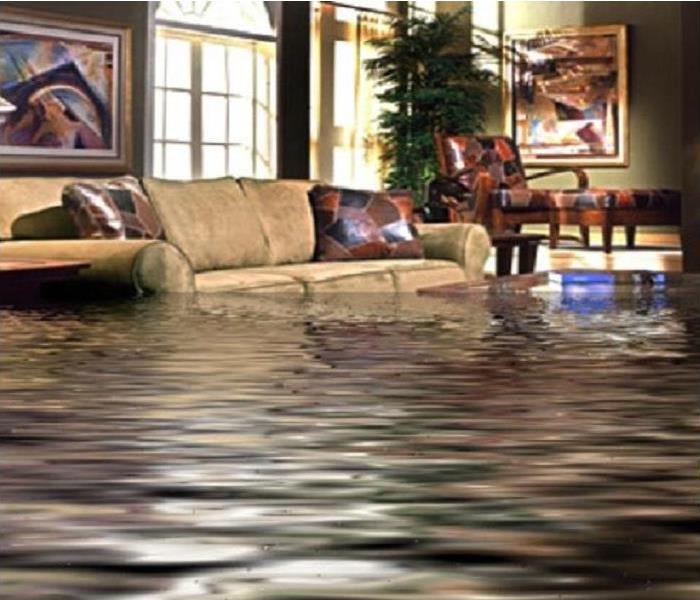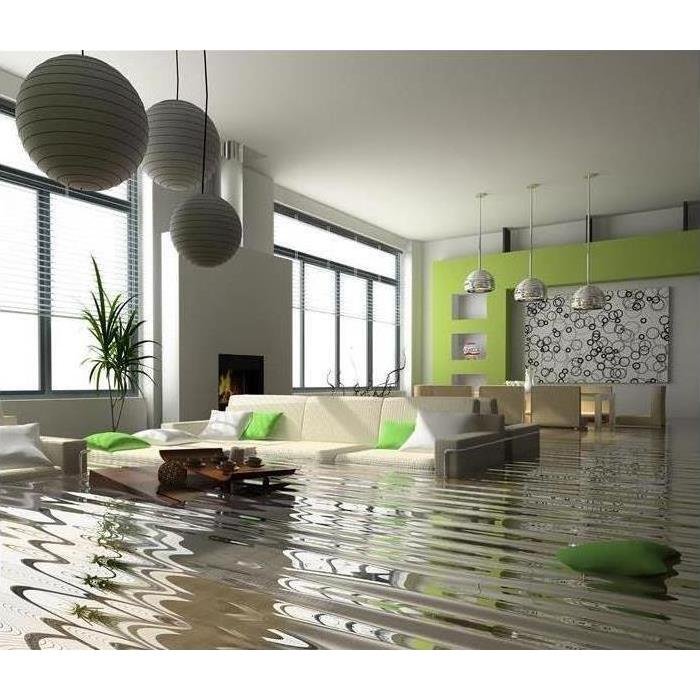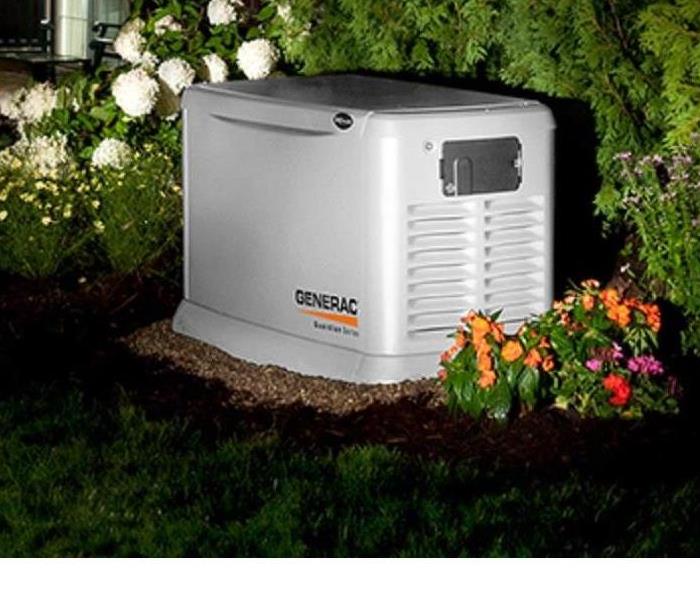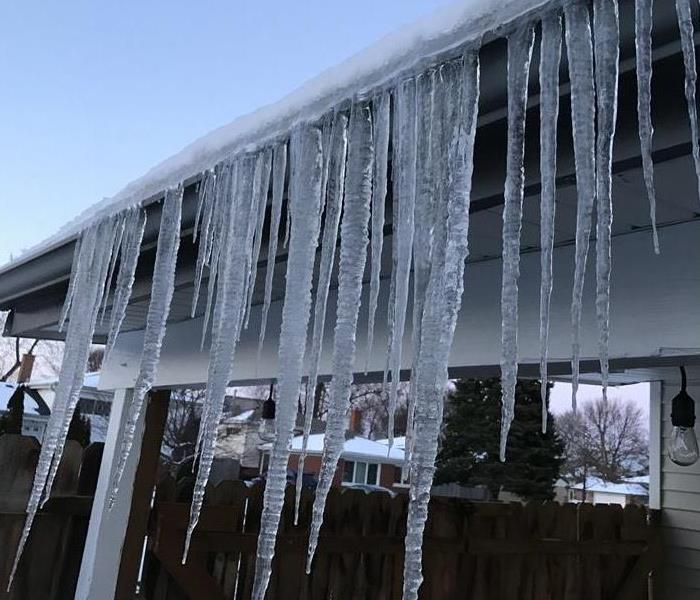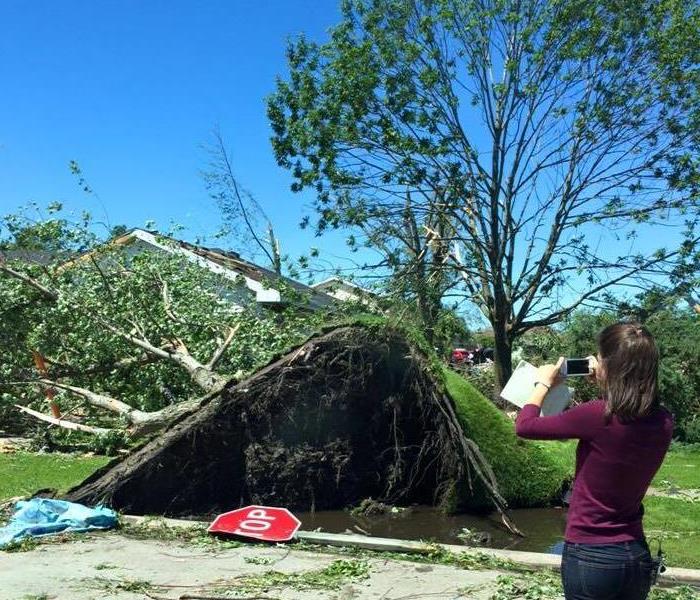Recent Storm Damage Posts
SERVPRO of Aurora Faster To Your Disaster
6/16/2022 (Permalink)
Being an industry leader with more than 1,400 franchises strong in cleanup and restoration, SERVPRO is equipped to handle any cleanup or restoration job no matter how large or small. With SERVPRO's Storm Response Team, SERVPRO of Aurora, Illinois has access to vast resources at its disposal to help with any situation.
When a natural disaster sweeps through a region, whether it's a wildfire, blizzard, flood, tornado or hurricane; SERVPRO of Aurora, Illinois Franchise Professionals knows your family can't afford to wait for your home to be restored to preloss condition. Every hour of unmitigated damage can cause more damage to your home or business and more stress and trauma to you or your family.
When disaster strikes, you need help, and you need it now. If the unthinkable happens and a natural disaster strikes your area, you can be sure SERVPRO of Aurora, Illinois will be there, working to make it "Like it never even happened." Call 630-862-3930.
After The Storm
6/3/2022 (Permalink)
This Spring and Summer has been quite a wet and stormy one and with that comes weather related injuries and fatalities. This is why it is important to educate both you and your family about post-storm safety.
Immediately after a storm where there was heavy rain, strong damaging winds, and lightening consider the following:
- Do not let children play near storm drains. Every year children are sucked into storm drains and carried away.
- Do not touch metal objects outside, there may be power lines down on the object which energizes the object. This could be a fence, guard rail, or baseball stop.
- Do not touch or pick up any wires that you see either laying on the ground or hanging low. They may be energized or could become energized at any time.
- Do not walk in flooded basements if your power is still connected. You could become electrocuted should water make contact with an electrical source.
- If your home is out of electrical power, use extra caution when using candles for light.
- Be careful using a gas powered generator which could cause Carbon Monoxide poisoning if not vented properly.
Please remember to keep you and your family safe and remember that SERVPRO of Aurora, Illinois is always available to help you with your restoration needs. 630-862-3930.
Warning Signs Of A Tornado
3/11/2022 (Permalink)
When a tornado strikes seemingly out of nowhere, it can cause intense damages - destroying buildings, flipping cars, and sending debris through the air. Knowing the signs of a tornado can help you get to a safe place before it hits.
Warning Signs of a Tornado
If you see these warning signs, go inside immediately and check your local weather announcements for watches or warnings.
- Dark, green tinted sky
- Wall clouds, or a cloud of debris
- A funnel-shaped cloud
- Large hail without rain
- Roaring noise, similar to a freight train
- Unusual calmness of wind
Tornado Watch Vs. Warning
A tornado watch means that the current weather conditions are right for generating a tornado. When these come through, you should keep an eye on the weather announcements for any changes and avoid going outside if possible until it has passed.
A tornado warning means that a tornado has been identified in the surrounding area and that you should immediately find shelter and take cover.
What Should You Do When A Tornado Hits?
When you get notification that your area is under a tornado warning, you should do the following according to ready.gov:
- If you are near a building, immediately go inside.
- Find a safe room, basement or cellar. If there is no basement, take shelter in a small interior room on the lowest floor of the building.
- Keep away from any windows, doors, or outside walls.
- Keep away from bridges or overpasses - look for low, flat locations to take shelter.
- Be aware of any flying debris that could injure you while outside.
- Be sure to use your arms to protect your head while moving about.
During a tornado, you should do the following:
- Stay in your safe location and do not leave until you know it is safe to do so.
- Better protect yourself from flying or falling debris by putting your arms around your head and neck and barricading furniture or blankets around you to protect from heavy objects.
- Continue listening to your local emergency or weather station for updates.
- If not in a safe building, do not try to outrun tornadoes in a car. Find a relatively sheltered, low place where you can put your arms over your head and crouch.
What Do You Do After?
- Continue listening for weather updates to ensure the worst is really over.
- If you are trapped, cover your mouth to try and not breath in dust or debris. Try and send a text, bang on a wall or a pipe, or whistle rather than shouting for help.
- Stay clear of any fallen power lines or trees.
- Do not reenter buildings that have been damaged until you're told it is safe.
- When cleaning up debris, be sure to wear thick gloves and work boots.
- Call your insurance company if your home or business has been damaged by the tornado.
When a tornado comes through your area, it can be a scary experience and can become overwhelming when it damages your home or business. After making the call to your insurance company, you should also call a storm damage restoration company to clean up debris, handle water damage, and repair any structural issues caused by the tornado.
What To Do After Flooding In Your Aurora Basement
2/7/2022 (Permalink)
Flooding can occur at the least expected times and be a huge headache to deal with, especially if you don’t know where to turn or who to call after it happens. Basements are common culprits of flooding due to their low-level, underground nature, which means water ends up accumulating there first. While your basement is in the process of flooding or immediately after the damage is done, here’s what you should do.
1. Don’t enter the flooded basement.
Although you may be tempted to start bailing out buckets of water, it’s safest to avoid the water and refrain from entering your basement. Instead, call your local professional restoration company and an electrician to come out and assess the aftermath. Since electricity flows through water, it poses a significant threat to you and your family members if the electricity isn’t’ properly dealt with beforehand. Turn off your circuit breaker only if your circuit breaker is located on the ground level or upper level of your home outside of the basement.
2. Remove excess water if it’s under two feet.
Once the electricity is turned off, it may be safe to enter your flooded basement and start bailing out water. The longer the water sits in your basement, the more damage it causes. Check out your sump pump and replace it to help remove the water, because there’s something obviously wrong with our sump pump if your basement is flooding in the first place. Using buckets, a mop, and towels can help soak up the water if the flooding isn’t that extensive.
3. Air out damp objects.
Anything damp in your flooded basement is subject to mold growth if it’s left unattended, so it’s essential that you remove any damp objects from your basement to air out to dry. Be sure to take some pictures and file an insurance claim as soon as you can after the flooding and damage are apparent. If your basement is finished, you should also rip out the wet carpet and padding underneath it. More times than not, your carpet will need to go in the trash.
4. Dry the flooded area.
Rent some fans and a shop vacuum to dry the area as quickly as possible to avoid mold growth and further destruction. You should also have a professional inspect the area to instigate any necessary repairs as well as prevent future growth. A dehumidifier may also be a smart investment to remove excess moisture from the air, which allows your basement to dry faster.
In the unfortunate event that you are faced with flooding in your basement, give SERVPRO of Aurora a call at (630) 862-3930. Our disaster restoration professionals are well-trained in water damage, storm damage, fire damage, and mold damage restoration services, and we’re available 24/7 to respond to any emergency situations.
Steps Before SERVPRO Gets There
1/18/2022 (Permalink)
If your home has sustained water damage due to flooding, there are many critical items to consider. Flood safety is your number one priority. If the flooding is extensive, your family and pets should leave the house immediately and call a storm damage restoration service. If the water is contained in a small area, you may be able to stay in your home until the restoration service arrives. In that case, there are several safety tips you should begin implementing right away.
How To Safely Remove Water From Your Home
Follow flood safety recommendations by turning off the electricity in the area that is affected. Put on rubber gloves to protect your hands as well.
Remove the water - If the flooring is a hard surface, such as linoleum, tile or cement, mop up the water and then wipe the entire surface with a dry towel. If you have carpeting, blot the wet area with clean rags or towels. Continue blotting until you have removed as much water as possible.
Move the furniture - Any moveable furniture and belongings that are located in the water-damaged area should be moved to a safe location and blotted or wiped dry. If the items are destroyed, throw them out right away. Call your local trash pickup service to make sure they will take the items. Otherwise, the restoration service will dispose of them when they arrive. Large items, such as sofas or beds, that can't be moved easily can be propped up on wood blocks. If you don't have any wood available, put sheets of aluminum foil under the legs.
Turn on the air conditioning - To help speed up the drying process, turn on your air conditioning unit. In very humid areas, such as basements, a dehumidifier is a great idea as well.
When Floods Happen - You Have To Deal With It As Soon As Possible!
12/21/2021 (Permalink)
When flooding occurs in buildings it needs to be dealt with as soon as possible in order to combat and prevent the litany of issues that come with a water damage. Flooding brings with it structural degradation, outside contaminants and bacteria, odor, warping, and possibly mold growth. All of which threaten both your home or business and the health of the people who reside within.
In order to take care of your flood damage in your home make sure you hire professionals who know how to prevent mold and deal with water, toxins and odor. Our technicians here at SERVPRO are specialized in handling the challenges posed by flood damage and know what needs to be done to ensure the highest standards in restoration service.
Going through any kind of damage to your home is a stressful experience that can put any homeowner on the edge. This is why we train our technicians to treat every job they go on whether it is a big or small damage with compassion and respect. We find that walking our customers through our process puts them at ease and lets them know they are in competent and responsible hands who will take care of their issue.
When flooding strikes your home, our technicians have the expertise to make it “Like it never even happened.” We are faster to any disaster and are here to help get you back to preloss condition.
Be Prepared for anything
11/12/2021 (Permalink)
You know storms are going to happen. Rather it be snow, rain, wind, etc. They are going to happen. To be prepared is a must. The following list is what is recommended at a minimum to be ready in the event of a storm.
- Battery Powered Weather Radio
Being prepared will help keep panic at a minimum. These items kept in a safe place where you go in the event of a storm for easy access is also necessary. Keep where you go in the basement or in possibly a bathroom closet if your home or business does not have a basement. Pick food items and bottled water that have long shelf lives. Make sure to test your batteries every month or so in your devices.
Residual Damage from Storms Can Cause Issues if Not Detected
9/23/2021 (Permalink)
The damage we see after a storm
Storm-related flood damage happens to homes every year. Once the downpour is over, the effects can be mild, like soggy area rugs, to minor issues such as leaky windowsills, to devastating such as a loss of walls and floors. Since these are easily spotted, it makes sense to call remediation specialists like SERVPRO who are ready with a highly trained team of technicians and years of experience to restore each home to its original condition.
The damage you may overlook after a storm
Since the rain strikes so quickly, it’s difficult for the ground around our homes to absorb all of the moisture. Pair with that the heavy rains and high winds that can cause damage to our roofs, and you can see why monsoons can cause so much damage. Unfortunately, sometimes that damage is difficult to see. Perhaps just enough water seeped into your roof through a small crack to slowly accumulate in your attic. It may not be enough to see if it doesn’t seep through to your ceiling with those telltale brown spots. Nonetheless, if left untreated, those small leaks can cause big problems. Not only does the water cause additional weakness in walls and ceilings, but long-standing water can cause mold growth. You may also experience water seepage behind walls that go undetected until mold growth appears.
How to detect unseen issues
Telltale signs of water damage in attics and ceilings might be the brown water spots that appear on ceilings or walls. You might also see bubbling of paint or bulging of drywall. Another sign of unseen damage is odor. Mold growth over time can cause a musty odor even before you see any kind of mold growth. All of these indicate a problem that needs to be addressed immediately; ideally provided by a storm remediation specialist.
Get help immediately to address issues
By the time you spot damage that has been lingering, chances are the situation has been there for a bit. That is why it is so important to call us immediately at the first sign of a problem. Not only can we address the damage or mold growth, but we’ll also identify the areas of weakness can address those as well to prevent future damage.
Prevent Water Damage After Rain Storm
7/29/2021 (Permalink)
Everyone can enjoy the occasional summer thunderstorm - but it could cause major problems if rain water seeps into your home. One of the most common sources of water damage in a home is from rain water. It can enter through leaks in your roof, seeping in from the foundation, or even flooding into your basement. It is important to take the necessary steps to prevent water damage in your home such as:
Checking for proper drainage:
- inspect your roof thoroughly for structural damage or holes
- clear your gutters from leaves and other debris that could block the flow of water from draining into the yard
Install or Check Sump Pumps:
- sump pump are very effective for keeping rainwater out of your house
- have a professional check your sump pump to insure it is working properly once a year
Check sealant inside and outside foundation
- make sure the tar sealant covering the inner and outer sides of the foundation are intact
Inspect the slope of your lawn
- grading is the slope of your lawn and it should always slope away from your home to redirect the rainwater from flooding around the foundations
SERVPRO can handle your Storm Damage
6/23/2021 (Permalink)
Storms can be unpredictable in the Midwest. Water and wind can cause damage to your home or business rapidly. Any damage to your home or business that allows water to seep into floors or ceilings can become costly repairs if not mitigated early. Therefore, SERVPRO of Lockport, Lemont, Homer Glen wants commercial business and homeowners to know that when damage occurs to your home or property due to a storm, we are available to help you. We will respond to your call quickly and will immediately begin the cleanup and restoration process. Here are some of the services we provide:
- Disaster Recovery Team
- 24 Hour Emergency Response
- Content Restoration
- Mold Remediation
- Sewage Cleanup
- Carpet Cleaning
- Odor Removal
- Commercial Storm Damage Cleanup
No matter what your storm cleanup and restoration needs may be, SERVPRO of Lockport, Lemont, Homer Glen wants to help. We are available 24 hours a day and have the specialized equipment necessary to restore storm damage to businesses and residences alike. We’ll take care of your storm damage “Like it never even happened.”
What To Do If A Tree Falls In Your Yard
4/21/2021 (Permalink)
As time passes and weather wears away at trees, trees eventually die and fall. Sometimes, a strong storm and wind expedite the process. However, you’re generally not notified in advance when a tree falls in your yard, so we’ve gathered a list of actions you should take if a tree falls in your yard.
1) Think about safety first.
Are you inside a building that the tree fell on? Where is the tree in relation to you and your family? Is the tree at risk of falling even further and causing more damage? If the tree has come in contact with any part of your home or fallen through your roof, you should get everyone outside of your home as soon as possible. Take note of any wires that your tree has knocked down or is now touching as they may pose a fire hazard. Any injuries or structural damage should elicit a call to 911 for the fire department to come and help you out.
2) Assess the damage.
Did the tree hit any existing structures? What kind of damage did it cause? Take photos of the damage for insurance purposes later and stay a safe distance from the tree if it’s at risk of moving even more during a storm, etc. Figuring out what exactly has been damaged and how is an important step in the process of what to do after a tree falls in your yard.
3) Determine whose tree fell.
Did your tree fall in your yard? Or is it your neighbor’s tree? Even if a neighbor’s tree fell on your home or into your yard, it’s typically your homeowner’s policy that covers the damage. This might seem a bit backward, but it’s the way most policies work. However, you should take note of whose tree it is and double-check with your insurance policy and coverage to see what applies and if the tree falls into any of the exclusions.
4) Call the insurance company.
After determining whose tree fell and assessing the damage, give your homeowners’ insurance company a call. Describe the situation and provide them with photographic evidence of the damage. They’ll be able to tell you the next steps to take and what you should do next.
5) Arrange for tree removal.
Once you’ve gotten in contact with your insurance company and you know what is covered under your policy, it’s time to arrange for tree removal. Your insurance company may provide you with a list of disaster restoration specialists that they work with, but it may be smart to come to them with a name in mind to see if that will be covered under your policy. SERVPRO of Aurora is a great disaster restoration company that can take care of tree removal, structural restoration, and more in the aftermath of storms, incidents, and other disasters.
Severe Weather Preparedness
4/16/2021 (Permalink)
Severe weather can happen any time, anywhere. Being prepared to act quickly can be critical to staying safe during a weather event. Knowing your risk of severe weather, taking action and being an example are just a few steps you can take to be better prepared to save your life and assist in saving the lives of others.
The first step to becoming weather-ready is to understand the type of hazardous weather that can affect where you live and work, and how the weather could impact you and your family. Check the weather forecast regularly, obtain a NOAA Weather Radio, and learn about Wireless Emergency Alerts. Severe weather comes in many forms and your shelter plan should include all types of local hazards.
Take the next step in severe weather preparedness by creating a communications plan for your family. Put together or purchase an emergency kit. Keep important papers and valuables in a safe place.
Once you have taken action to prepare for severe weather, share your story with family and friends on Facebook or Twitter. Your preparedness story will inspire others do the same.
Severe Weather Safety
4/1/2021 (Permalink)
Hundreds of people die each year in the United States due to heat waves, hurricanes, lightning, flash floods, powerful thunderstorm winds, and winter storms or winter cold. Additionally, thousands of people are injured by these weather events each year. If you are aware of what weather event is about to impact your area, you are more likely to survive such an event. To stay on top of the weather, utilize NOAA Weather Radio All Hazards receiver units that can be purchased at most electronic stores. Make sure the model you purchase has a battery-backup. You should also obtain the latest weather information from commercial TV/radio, cable TV, the internet/web, and newspapers. It’s your responsibility!
What else can you do to prepare for severe weather?
- Develop a disaster plan for you and your family at home, work, school, and when outdoors. The American Red Cross offers planning tips and information on a putting together a disaster supplies kit at www.redcross.org.
- Identify a safe place to take shelter.
- Know the county in which you live or visit – and in what part of that county you are located. The National Weather Service issues severe weather warnings on a county basis.
- Check the weather forecast before leaving for extended periods outdoors. Watch for signs of approaching storms.
- If severe weather threatens, check on people who are elderly, very young, or physically or mentally disabled. Don’t forget about pets and farm animals.
Insurance Tips For Making a Storm Claim
2/24/2021 (Permalink)
Here at SERVPRO of Lockport, Lemont, and Homer Glen we work closely with many Insurance companies. One in particular is American Family Insurance. Here are some tips from them on making a storm damage claim.
Act Quickly. Filing a claim with your insurance company in a timely matter is very important. Most insurance policies limit your time to file a claim, so being quick is essential. You will want to repair the damage before it has a chance to get worse.
Review your policy. Every insurance policy and claim is different. If you know what your policy covers, you will be better prepared to plead your case.
Document everything. Keep a log of the storm and the damage. Do NOT start to clean up until you have documented as much of the damage as is safe and wait to handle the big messes until a claims adjuster has assessed the situation.
Mother nature likes to shake things up and if your home didn't weather a storm as well as you'd hoped it would, keep these tips in mind to help you along the way.
If you have experienced storm damage in your home or business call SERVPRO of Lockport, Lemont, Homer Glen. We specialize in finding, assessing and repairing damage from storms!
Best Helpful Hints to Get You Through the Winter and Storms
1/10/2021 (Permalink)
- Ceiling fans are not just for summer: flip the switch to reverse the spin of the fan and turn on the lowest speed to blow warm air down from ceiling.
- Use energy from the Sun: During the day, open drapes and blinds to allow sunlight to help warm the house, land then close at night to hold in heat.
- Dress in Layers: Pack an extra pair of warm socks, blankets, wool sweaters and long-johns or coveralls in your car to keep warm.
- Keep a bag of clay kitty litter in car: If your car gets stuck in deep snow or slick ice, sprinkle kitty litter (non-clumping) at the base of your tires to add some traction to get moving again. Extra weigh in trunk will create added pressure on your tires, ensuring greater contact between your tread and the ground.
- Don’t smoke or drink coffee before shoveling: Caffeine and nicotine are stimulants and can add extra stress to the heart.
- Learn to walk like a penguin: To walk safely on ice, walk like a penguin. Point your feet out, land hold your arms out slightly to your side. Shuffle, land take short steps.
- Easy deicer: The night before freezing temperatures, rub half a potato over your car’s windshield. The sugar from the potato creates a barrier over the window and prevents ice from forming, when you come out in the morning you will not have to scrape! Simply rinse and wipe with your wipers when you get on the road.
- Gas Up: During cold weather months, it is good practice to keep at least a half tank of gas in your vehicle at all times. Not only does it prevent you from being stranded, but it prevents any water in the tank from freezing, which can damage the fuel pump.
- Frozen locks: Squirt a little hand sanitizer on them. The isopropyl alcohol that kills germs also lowers the freezing point of water, and can melt the ice inside the lock within seconds.
- Grab a roll of duct tape and keep it in car: Not only does it fix everything, but you can use it as a fire starter – duct tape is very flammable and is a great tool to get a fire going in an emergency. Don’t forget to have a lighter or matches in your emergency kit.
- Candles: will keep you warm in your car if you are stranded in car. Also, don’t forget to have a lighter or matches.
- No more icy walkways: Sprinkle leftover coffee grounds on your freshly shoveled walk or driveway to help melt the ice – it’s a natural and environmentally friendly way to add more traction underfoot. Remember to wipe feet when going inside.
- Dry wet shoes: by stuffing them with dry newspaper to absorb the moisture quicker.
- Shoveling Snow: Spay shovel with non-cook cooking spray, snow will slide off easier.
- Winter Survival Kit to keep in vehicle: Flashlight, batteries, snacks, water, ice scraper, first aid kit, candle and lighter, phone charger, warm outer clothing and travel shovel.
What Are the Most Common Types of Storm Shutters?
12/29/2020 (Permalink)
Protect Your Windows From High Winds
When there’s a storm on the horizon, it’s important to protect your home’s windows from being damaged by high winds and flying debris. There are many ways to safeguard your windows if Aurora, IL, is in a storm’s path.
Temporary Options
Some storm protection methods are temporary; you only put them up for storms. These methods cost less than permanent options, but they require more time and effort to install when a storm is approaching:
Plywood: The most inexpensive method of protection is cutting plywood panels to fit your windows. To be effective, they must be thick enough and installed correctly.
Fabric Screen: These are sheets of strong, storm-rated material that attach to the outside of your windows using clips or grommets. They’re lightweight and easier to install than plywood.
Storm Panels: These panels are made from aluminum, steel, or polycarbonate and bolt over the outside of your windows. They are typically lighter and easier to install than plywood.
Permanent Options
Some types of storm shutters are permanently affixed to the outside of your windows. They are more costly than temporary methods but once installed can be put into place much more quickly:
Bahama: These decorative shutters are permanently attached to the top of a window, like large awnings. They can be quickly bolted closed when high winds are predicted.
Accordion: These window coverings are hinged, like an accordion, and are typically made of aluminum, steel or polycarbonate. They fold up into a box that’s permanently attached to one side of a window, and you pull them across the window and lock them into place.
Colonial: These hinged shutters attach to both sides of a window and can be latched together across the window.
Roll-Down: These coverings are mounted above a window. They roll into place along tracks that are mounted on both sides of the window.
Protecting your home’s windows from high winds involves an investment of time and money. However, when you consider the possibility of extensive storm damage restoration or even the loss of your home, storm shutters are worth the cost.
Is Your Business Prepared To Evacuate in the Event of an Emergency?
10/6/2020 (Permalink)
While an emergency in the workplace is never expected, disasters happen every day in businesses all around the country. That’s why it’s so important to implement a fire drill plan for your employees and customers. By keeping a few simple guidelines in mind when designing your evacuation procedure, you can make sure your business in Auburn, WA, is prepared for a worst-case scenario.
1. Pay attention to details.
Where is a fire most likely to break out in your building? How is the customer traffic flow designed? What are the locations of sprinklers and fire extinguishers? These are factors that will need to be considered when planning for an emergency. Map your evacuation route to bypass dangerous areas and allow for the fastest possible exit from the building.
2. Communication is key.
Even the most well designed fire drill plan is useless if you don’t ensure that every employee knows how to implement it. Keep in mind that your employees will need to guide customers to safety in the event of an emergency, so it’s imperative that they have access to a printed evacuation route and are aware of where all the building exits are located.
3. Repeat, repeat, repeat.
Even the most level headed employee can panic if a fire breaks out at work. That’s why evacuation drills should be rehearsed on a regular basis to make sure that everyone knows their role in an emergency. Address any issues or confusion after each drill to develop a reliable exit strategy. Shift leaders and managers should have the contact information for a reliable fire damage restoration company to call after ensuring that all customers and employees are out of the building and first responders are on the way.
While no business owner wants to think about a life threatening emergency in their building, it’s crucial to have a fire drill plan in place to ensure the safety of your employees and customers. By remembering to prepare for the worst-case scenario, you can prevent a tragedy from occurring.
Being prepared for a Storm and Flood
9/8/2020 (Permalink)
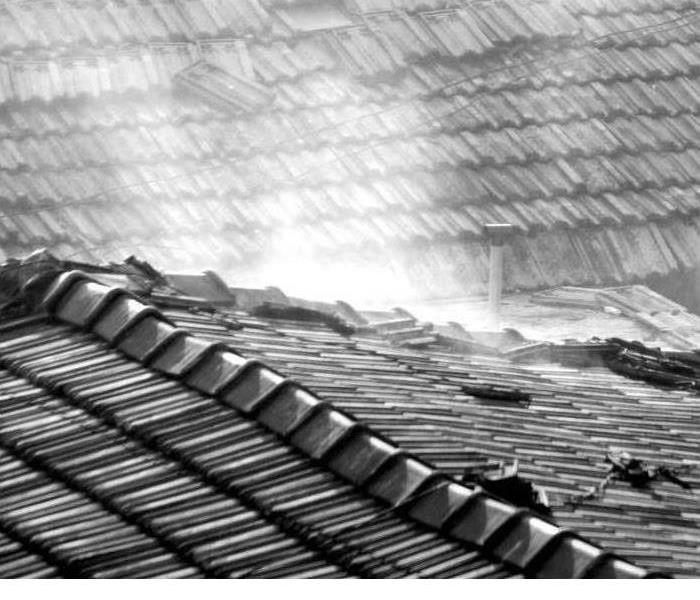 Storms, Flood or any kind of damage. Call the professionals at SERVPRO of Aurora.
Storms, Flood or any kind of damage. Call the professionals at SERVPRO of Aurora.
Sometimes a storm can bring some serious water damage, even a flood. Are you prepared for a flood? Most people aren’t, so here are a few tips to be storm and flood ready!
- Water (A 3+ day supply; one gallon per person per day.)
- Food (3+ day supply of non-perishable, easy-to-prepare food.)
- Flashlight
- Battery-powered or hand-crank radio (NOAA Weather Radio, if possible)
- Extra batteries
- First Aid Kit
- Medications (7 – day supply) and medical items (hearing aids with extra batteries, glasses, contact lenses, syringes, cane)
- Multi-purpose tool
- Sanitation/personal hygiene items
- Copies of personal documents
- Cell phone with chargers
- Family and emergency contact info
- Extra Cash
- Emergency blanket
- Map(s) of the area
- Baby supplies (bottles, formula, baby food, diapers)
- Pet supplies
- Tools/supplies for securing your home
- Extra set of car keys and house keys
- Extra clothing, hat and sturdy shoes
- Rain gear
- Insect repellent and sunscreen
- Camera for photos of any damage
How Much Damage Can a Winter Storm Do?
8/11/2020 (Permalink)
 Open closet doors and cupboards open during the winter months to keep pipes warm if they are prone to freezing.
Open closet doors and cupboards open during the winter months to keep pipes warm if they are prone to freezing.
How Much Damage Can a Winter Storm Do?
To those who haven't experienced a severe winter storm, it can be difficult to understand why many northern cities devote so many resources to dealing with winter weather. Snow, after all, can seem relatively harmless or even evoke fond memories of childhood fun. It is extremes in temperature and precipitation, however, that result in severe property damage.
1. Temperature Damage
Water has an unfortunate tendency to expand during the physical process of freezing. Since pipes and other water vessels tend to hold standing water, you should always keep your house at a high enough temperature to ensure that no section of piping is liable to freeze. If you expect temperatures to remain extremely cold for an extended time, run faucets periodically so that your water supply has a chance to regain heat energy. A burst pipe can cause flooding that results in costly damage to your home.
2. Roof Cave-ins
A blizzard that features high winds and snow accumulation may create enough force to cave weak sections of roofing. This can result in additional damage if snow is allowed to accumulate through the breach into your home. Since winter storm cave-ins are likely to expose occupants to unpleasant outdoor conditions, you should have a professional tarp any roof damage as soon as possible.
3. External Problems
Both trees and power lines are notoriously susceptible to collapse in the wake of freezing rain or blizzard conditions. In a worst-case scenario, either can cause roof damage or damage to other exterior surfaces on your home. A power outage can prevent you from heating your home or doing necessary tasks. The best way to deal with collapses is to anticipate them before they happen.
If your home in Aurora, IL has suffered winter storm damage, contact a restoration expert immediately. If you live in the path of frequent blizzards, you should familiarize yourself with local standards for storm damage prevention so that you can rest easy when winter comes.
Sump Pump Maintenance
7/17/2020 (Permalink)
If you have a sump pump, most the time you don't realize how important it is until it stops working. Power outages, failure and a sump pump that cannot handle the capacity are common problems. Another is knowing how old is your sump pump?? Avoid potential problems by doing routine inspections or replacing your old sump pump. Usually sump pumps should be replaced every 5 years or according to manufacturers guidelines and each year the sump, switch and float should be inspected as well. Pay attention to how often the sump pump is running and if it runs regularly or there is a higher water table, consider a sump pump with higher horsepower.
Another way to increase the pump's efficiency and prolong life is to clean your sump pit, remove any dirt, sand, gravel and other debris routinely. Ensure that the discharge line opening is free of obstructions so that water can be pumped through the line and out of your basement or crawlspace and also be aware in the winter the discharge line may freeze bringing the water back into your house. Regular checks can make sure you don't ever get surprised by your sump pump!
The Top 5 Flood proofing Tips
4/28/2020 (Permalink)
 Rain garden in Kaneville, IL
Rain garden in Kaneville, IL
Five Ways To Avoid Flood Damage
Floods can cause thousands of dollars of damage to building materials and contents. Here are five of the best ways to avoid the worst consequences of flood damage, promote flood safety, and make a residence in Kaneville, IL, more flood-proof.
1. Elevate Essential Systems
Raise electrical, HVAC, and other essential appliances above flood level. These components can be adjusted upward on lower floors or moved to a higher floor to significantly reduce risks of damage and electrocution.
2. Take Dry Floodproofing Measures
Dry floodproofing involves making doors and windows more watertight and applying membranes or sealants to walls to discourage seepage. These measures can reduce the amount of flood water that enters a residence, limit the extent of water damage cleanup, and promote flood safety.
3. Take Wet Floodproofing Measures
Wet floodproofing measures require more extensive remodeling. A crawl space can be redesigned to allow flood water to pass under some homes without pooling. Other techniques include the use of flood-resistant building materials and specialized equipment such as flood vents.
4. Install Sewage Backup Prevention
There are several ways to discourage backups. A backflow prevention valve permits sewage to go out but does not allow a return flow of wastewater. Plumbing professionals may also recommend measures such as an air gap, barometric loop, or vacuum breaker.
5. Strategically Adjust the Landscaping
It may be possible to modify the grade or slope of the land surrounding a home or add features such as swales or rain gardens. Consult with landscaping professionals to determine the best way to stop water from accumulating around the base of a structure.
Even after implementing these safety tips, flood water may still enter a residence in Kaneville, IL. Standing water can damage building materials, contaminate contents, and pose flood safety risks. Reduce the out-of-pocket cost of restoration by maintaining flood insurance and sewer backup coverage.
3 Storm Preparation Tips You Should Know
4/3/2020 (Permalink)
 One way to avoid water damage on the roof is to ensure that gutters are clear of debris
One way to avoid water damage on the roof is to ensure that gutters are clear of debris
Storm Preparation Tips
When your Sugar Grove, IL, business experiences a storm, there’s a chance that flood water can cause some problems. Fortunately, a local water damage restoration service can help with clean up and repairs. However, you may want to do what you can to mitigate possible damages beforehand. Here are three tips you may want to know.
1. Clear Gutters
One way to avoid water damage on the roof is to ensure that gutters and downspouts are clear of debris. A clogged gutter can overflow and cause water to backup onto the roof where it runs the risk of causing a leak. Removing any loose twigs, dead leaves, dirt, and other materials before the storm arrives can help prevent this from happening.
2. Backup Data
It’s important to back up all computer data just in case your electronics are damaged by flood water. You may choose to have an external server available, or have a cloud setup where data can be saved. There are also many IT services available for companies where professionals can backup your data for you. If a computer does experience water damage, a restoration professional may be able to repair the device.
3. Create Flood Barriers
Another way to help avoid a flooded building is to use or create flood barriers. There are many collapsible barriers already available which can be set up at-need and then deflated or refolded for storage. Alternatively, you may choose to use sandbags. These should be set up in a way to prevent water from reaching areas like doors and window wells while encouraging the flow toward a drainage safe location such as a drainage ditch or empty lot.
Mitigating damage from floodwater beforehand can help save your business time on repairs. Remember to clear any debris from drainage gutters, back up computer data, and create flood barriers around doors and any window wells. If damage does occur a restoration service can help.
Power Outages
10/15/2019 (Permalink)
Extended power outages may impact the whole community and the economy. A power outage is when the electrical power goes out unexpectedly. A power outage may:
Disrupt communications, water, and transportation.
Close retail businesses, grocery stores, gas stations, ATMs, banks, and other services.
Cause food spoilage and water contamination.
Prevent use of medical devices.
PROTECT YOURSELF DURING A POWER OUTAGE:
Keep freezers and refrigerators closed.
Only use generators outdoors and away from windows.
Do not use a gas stove to heat your home.
Disconnect appliances and electronics to avoid damage from electrical surges.
Have alternate plans for refrigerating medicines or using power-dependent medical devices.
If safe, go to an alternate location for heat or cooling.
Check on neighbors.
HOW TO STAY SAFE WHEN A POWER OUTAGE THREATENS:
Prepare NOW
- Take an inventory of the items you need that rely on electricity.
- Talk to your medical provider about a power outage plan for medical devices powered by electricity and refrigerated medicines. Find out how long medication can be stored at higher temperatures and get specific guidance for any medications that are critical for life.
- Plan for batteries and other alternatives to meet your needs when the power goes out.
- Sign up for local alerts and warning systems. Monitor weather reports.
- Install carbon monoxide detectors with battery backup in central locations on every level of your home.
- Determine whether your home phone will work in a power outage and how long battery backup will last.
- Review the supplies that are available in case of a power outage. Have flashlights with extra batteries for every household member. Have enough nonperishable food and water.
- Use a thermometer in the refrigerator and freezer so that you can know the temperature when the power is restored. Throw out food if the temperature is 40 degrees or higher.
- Keep mobile phones and other electric equipment charged and gas tanks full.
Hire Professionals Who Understand
9/5/2019 (Permalink)
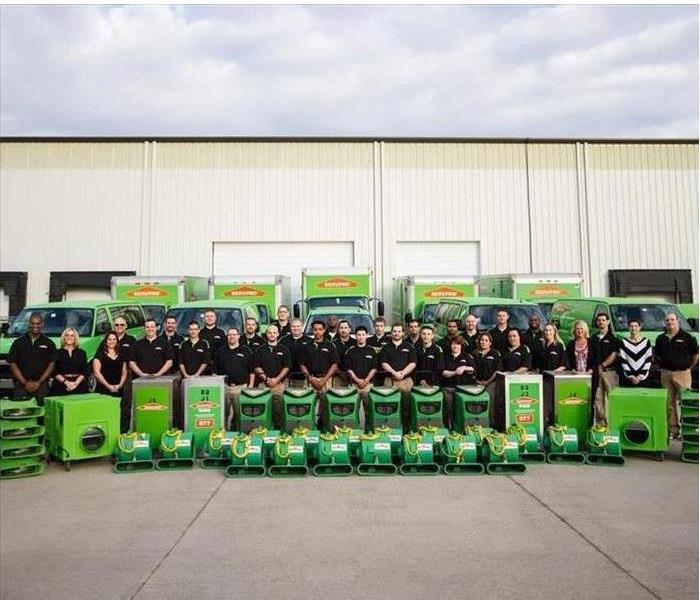 SERVPRO of Aurora Team
SERVPRO of Aurora Team
Whenever you have a problem with your home, the first impulse is usually to tackle the problem yourself. Sometimes this can be the right choice, and the problem’s easy enough to solve on your own. Other times it’s much safer and smarter to call in the pros from the beginning.
Tracking down tricky leaks is one of those times. Sure, some leaks are easy to track down, but water has a way of traveling odd paths. So once finding a leak gets tough, then it’s time to call in some help. And here’s why:
They Know Where to Look
Water can travel strange paths before it finally comes out into your home, and you might be surprised how far it can come. That discolored spot on your basement ceiling could actually be caused by a leak in your roof, or your wall on the opposite side of the house.
Professionals have tracked down hundreds, even thousands of leaks over the years. That experience gives them a wide variety of usual suspects to check, and a good number of unusual ones, too.
They Know What to Look For
That slight, turquoise line along your copper pipe? That’s where water has run along the outside and caused the copper to oxidize. It’s a sure sign that a leak is sending water traveling on the wrong side of the pipes.
Pros know these and dozens of other signs. What looks like a bit of dirt to you might indicate a serious leak in your roof, foundation, or wall. Or it might just be some dirt. A professional will be able to know the difference for certain.
They’ve Got the Right Equipment
Most of us can only use our eyes or sense of touch to lead us to water, but not the professionals. They have a wide variety of specialized equipment that can sense moisture and humidity through walls or probe underground for water deposits using ground penetrating radar.
This equipment can be expensive to buy and tricky to use. They have years of experience using the equipment, and know how to put it to good use.
SERVPRO of Aurora - (630) 862-3930
How Technology Impacts Water Damage Restoration
7/18/2019 (Permalink)
 Drones
Drones
Like everything in life, things change and processes get redeveloped to make things quicker, more efficient and with the end result in mind. This blog is going to talk about the various technologies that are used in water damage cleanup.
One such technology that is relatively new to the restoration industry is the use of drones to determine where water damage resides. Drones can find water damage in areas where it is deemed unsafe to roam into. With this access, the drone can also take pictures from angles that are not possible by a crew member and helps the insurance company to value out and determine what areas can be removed and what areas can be dried and or salvaged.
Another technological innovation within restoration is thermal imaging. This along with moisture readings can help to ensure that the structure can maintain a strong integrity after a water loss and keep the materials in line with the environmental conditions surrounding the material.
In the event of water damage in the Aurora, you can call your local SERVPRO experts at (630) 862-3930.
Tricks to Avoid Flooding
6/4/2019 (Permalink)
It is also important to keep your building’s drains clear. Clean leaves and dirt out of gutters at least once every other month. Make sure that ditches around your property don’t become trash receptacles. Keep It Green Your landscaping can help with flood prevention. Adding plants around your building can slow the flow of floodwaters. Flower beds can be built with water reservoirs under them, giving excess rain a place to go, if necessary. Trees and other plants with extensive root systems can combat erosion, preventing mudslides and the subsequent damage to your foundation. Keep It Routine Flood cleaning experts recommend that you adhere to a consistent inspection schedule. Building codes are in place to protect both the city and the building owner from preventable damage. By noticing problems and repairing them quickly, you can protect both your building and the infrastructure that supports it. Flood prevention works best when every entity at every level works together. If you do everything you can do to protect your building and the property on which it is built, you can help the city with its emergency flood plan as well.
Wireless Emergency Alerts
2/23/2019 (Permalink)
Wireless Emergency Alerts
Wireless Emergency Alerts (WEA) are emergency messages sent by authorized government-alerting authorities through your mobile carrier. Government partners include local and state public agencies, FEMA, the FCC, the Department of Homeland Security, and the National Weather Service.
Alerts received at the right time can help keep you safe during an emergency. With WEA, alerts can be sent to your mobile device when you may be in harm's way, without need to download an app or subscribe to a service. WEA may be used to share;
- Extreme weather warnings
- Local emergencies requiring evacuation or immediate action
- AMBER alerts
- Presidential Alerts during a national emergency
A WEA will look like a text message, and typically show the type and time of the alert, any action you should take, and the agency issuing the alert. The message will be no more than 90 characters.
Visit www.ctia.org/weato learn more about Wireless Emergency Alerts, including how to determine if your mobile device is WEA-capable.
"Stormy Weather"
1/16/2019 (Permalink)
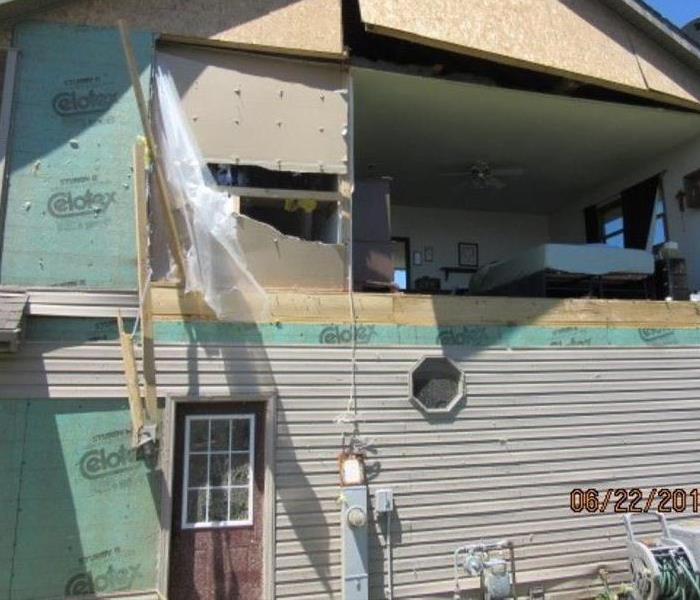 The tornado removed the entire outer wall with out touching the content and even a cross remains on the wall.
The tornado removed the entire outer wall with out touching the content and even a cross remains on the wall.
June 22, 2015 is a date that the residents of Coal City, Illinois will never forget. An EF-3 tornado, with winds estimated at 160 miler per hour ripped through the town causing wide spread devastation to the community. SERVPRO of Aurora, Illinois was called in to assist with the damages. We were given the opportunity to help families try to get their lives back to some kind of order considering what they had just been through. When a disaster hits, it is not always about the property damage but also about being compassionate and caring of each individual affected by it.
"During a difficult time, SERVPRO was respectful, helpful, professional, and made a horrible situation better." - Kristin C.
"At a difficult time in our lives, SERVPRO was caring, supportive, and attentive, thank you!" - Lance C.
It is comments like these that make us proud to be the company we are today: from taking care of all their personal belongings and content, to cleaning and rebuilding the damage done to their homes and properties.
Our highly trained professionals are available 24/7, 365 days a year, to handle any disaster from beginning to end and make it "Like it never even happened." If ever the need arises, call 630-862-3930.
Tips to Prepare Your Home for Winter Ice Storms
11/14/2018 (Permalink)
Winter is once again coming and along with it comes one of your home's worst enemies; ice dams. Ice dams are continuous chunks of ice that form along the edges of your roof. During the warmer parts of a winter day, water melting off the roof pools behind the ice and then seeps back up under the shingles; causing damage to the interior of your home. To try and prevent ice dams, you have a few options:
- Make sure all gutters and downspouts are cleared of trapped leaves and debris.
- Being very careful, try to remove the snow off your roof after a heavy snowfall with a snow rake or call in a professional who can provide that type of service. Usually this can only be done on a single story home.
- Make sure that your attic is properly insulated and vented. Building codes require 12' to 14" of insulation.
- The next time you re-roof, run a special adhesive ice-and-water barrier 3" to 6" up the roof from the edge. It can be rather expensive but can save you money in the long run.
- Have heat cables installed on the edge of your roof where ice usually dams up.
As hard as we try to control some of the things that mother nature throws at us, it doesn't always work out. If you suspect you may have damage to your home due to ice damming or any other cause, give SERVPRO of Aurora, Illinois at 630-862-3930 and we will send our trained professionals to help you with your problem.
Preparedness for Pets
10/12/2018 (Permalink)
After Hurricane Katrina it was estimated that over 15,500 animals were ultimately rescued. Of the 15,500, only 15-20% were reunited with their owners.
Pets are just as important as any family member to most people so make them part of your preparedness planning. Several things that you can do to make sure they stay safe during an emergency are:
Build a Pet Emergency Kit
- Food - At least a three day supply in an airtight, waterproof container.
- Water - At least a three day supply.
- Medicines and medical records
- Important documents - such as registration, adoption and vaccination papers.
- First Aid Kit
- Collar or harness with ID tag, rabies, tag and leash
- Crate or pet carrier - Have a sturdy, safe crate or carrier in case you need to evacuate. There should be enough space for the pet to stand, lie down or turn around in.
- Sanitation - Pet litter and litter box, newspapers, paper towels, plastic trash bags, and antibacterial wipes.
- Picture of you and your pet together - If you become separated, the photo will help as documentation of ownership and help others to assist you.
- Familiar items - Not only is this a traumatic time for, but also for your pet. By having some items such as treats, toys and bedding make help alleviate stress on your pet.
Most important of all is to include your pet in your evacuation plans and don't leave them behind where they can be lost or injured. It is very important to have your pet micro chipped. In the event that you do get separated from your pet, it will be much easier for the animal to be traced back to it's owner.
For more information visit ready.gov/animals and remember that SERVPRO of Aurora, Illinois 630-862-3930 knows that not only are your personal items important to you but so are your family pets. Keep them safe and be prepared!
Generator Safety
8/15/2018 (Permalink)
If you have a generator available for power outages during severe weather, follow some safety tips below from the American Red Cross:
- Never use a generator, grill, camp stove or other gasoline, propane, natural gas or charcoal-burning devices in your home, garage, basement, crawl space, or any partially enclosed area.
- To avoid electrocution, keep the generator dry and do not use in rain or wet conditions. Operate it on a dry surface under an open canopy-like structure, such as under a tarp held up on poles. Do not touch the generator with wet hands.
- Opening doors and windows or using fans will not prevent carbon monoxide (CO) buildup in the home. Although CO can't be seen or smelled, it can lead to full incapacitation or even death. While using a generator; if you start to feel sick, dizzy, or weak, get to fresh air immediately.
- Install CO alarms in central locations on every level of your home or property and outside sleeping areas to provide early warning of accumulating carbon dioxide.
SERVPRO of Aurora, Illinois is always there to help you weather the storm. Call 630-862-3930.
StormReady not Storm Proof
6/12/2018 (Permalink)
The city of Aurora was one of the first municipalities in Illinois awarded the "StormReady" designation. The top goal of StormReady is to prepare communities with an action plan that responds to the threat of all types of severe weather from tornadoes to winter emergencies.
Once a community meets preparedness criteria, outlined by the partnership between the National Weather Service and state and local emergency managers, it is considered "StormReady," StormReady communities are better prepared to save lives from the onslaught of severe weather through better planning, education, and awareness.
StormReady does not mean storm proof. You must always have a plan and be prepared before dangerous weather arrives. Visit the StormReady website for information on how to be prepared and remember, SERVPRO of Aurora, Illinois is always available to help you with your cleanup and restoration needs, 630-862-3930.
Tornado Season Is Upon Us!
5/14/2018 (Permalink)
Tornadoes are violent and can completely destroy well-made structures, uproot trees and send objects through the air like deadly missiles and they can happen anywhere. Here are some tips to keep you and your loved ones safe.
- Identify a save place in your home where family and pets will gather during a tornado: a basement, storm cellar or an interior room on the lowest floor with no windows.
- In a high rise building, if you don't have have enough time to go to the lowest floor, pick a hallway in the center of the building.
- In a mobile home, choose a safe place in a nearby sturdy building. If your mobile home park has a designated shelter, make it your safe place. No mobile home is safe in a tornado.
KNOW THE DIFFERENCE!!!!
Tornado Watch: means a tornado is possible.
Tornado Warning: means a tornado is already occurring or will occur soon. GO TO YOUR SAFE PLACE IMMEDIATELY.
Always remember to play it safe and we are always here, if you need us. SERVPRO of Aurora, Illinois 630-862-3930
Build an Emergency Kit
4/26/2018 (Permalink)
Be Prepared at your home or business with an Emergency Kit. Ready.gov suggests you have enough supplies to last for at least three days. Below are some suggested items to include in your kit:
- 3-day supply of non-perishable foods
- Water (one + gallon per person per day)
- Prescription medication
- Sleeping bag or blankets
- Fire extinguisher
- Hygiene products
- Flashlights
- Extra batteries
- Cell phone charger
- Change of clothes
- Matches in waterproof container
- Wrench or pliers to turn off utilities
- Whistle to signal for help
- Pet supplies
- Infant formula and diapers
- Important documents such as insurance policies, ID's, and bank records in a container
You can also keep a condensed emergency kit in your vehicle as well. For a more extensive list, check out Ready.gov. and remember, if needed; we are her to help you, call SERVPRO of Aurora, Illinois at 630-862-3930.
April Showers Bring May Flowers
4/25/2018 (Permalink)
Hopefully April Showers will bring you May Flowers. May is a very busy month as school is coming to an end and summer is just around the corner.
The same is true for preparedness planning in May. The following preparedness events take place this month and offer a great chance to educate yourself, family, and friends.
- Wildfire Community Preparedness Day (May 5, 2018)
- National Hurricane Preparedness Week (May 6-12, 2018)
- National Dam Safety Awareness Day (May 31, 2018)
- National Building Safety Month
May also brings to weeks to show appreciation for first responders:
- National Police Week (May 13-19, 2018)
- National Emergency Medical Services (EMS) Week (May 20-26, 2018)
Be sure to visit ready.gov for more information and resources and remember SERVPRO of Aurora, Illinois 630-862-3930 is ready in any disaster to make it "Like it never even happened."
When storms or floods hit Aurora, IL, SERVPRO is ready!
4/10/2018 (Permalink)
SERVPRO of Aurora, IL specializes in storm and flood damage restoration. Our crews are highly trained and we use specialized equipment to restore your property to its pre-storm condition.
Faster Response
Since we are locally owned and operated, we are able to respond quicker with the right resources, which is extremely important. A faster response lessens the damage, limits further damage, and reduces the restoration cost.
Resources to Handle Floods and Storms
When storms hit the Aurora, Illinois area we can scale our resources to handle a large storm or flooding disaster. We can access equipment and personnel from a network of 1,650 franchises across the country and elite Disaster Recovery Teams that are strategically located throughout the United States.
If you have a storm or flood damage call SERVPRO of Aurora, IL at 630-862-3930 and we will make it "Like it never even happened."
Make Sure Your Aurora, Illinois Home is Storm Ready
4/10/2018 (Permalink)
Storms in the springtime are something we need to be ready for. We watch the news, but bad weather is still unpredictable, so we need to take steps to keep our homes safe from storm damage.
It is a really good idea to conduct an inspection of your home and grounds before inclement weather hits. A leaky roof or window can cause big problems during heavy rainfall and strong winds. Do all of your exterior doors and windows fit correctly? When was the last time you took a good look at your roof? These are all great questions to keep in mind.
Loose shutters and unstable large trees and bushes can present a real problem in high winds. Its a good idea to trim back trees and bushes with large, heavy branches that are not in good condition so that windows and vehicles are not in danger of storm damage in windy conditions.
Many homes in older cities have drainage ditches or creeks on the property. Take time to inspect these areas and remove debris or dirt that might obstruct the flow of water from a heavy rain. A clogged drainage ditch or creek bed can cause a lot of damage by flooding your property during, or even after, a storm.
In the event of a storm, do you have a system in place that will help you get information to everyone you care about in case of a weather emergency? Most of us use our cell phones to communicate these days, but in the case of a bad storm, your cell phone service could be at risk. You might consider a good old-fashion landline, just in case. If you or a family member gets stuck at work or out doing errands, others will worry, so keeping those lines of communication open can keep everyone safe and worry-free.
The SERVPRO team at Aurora, Illinois is here to help in the event of storm damage, fire damage, or mold issues. Call SERVPRO of Aurora, IL and we will make it "Like it never even happened."
Severe Weather Safety
3/16/2018 (Permalink)
Severe weather can happen any time, anywhere. Each year, Americans cope with an average of the following intense storms (noaa.gov):
10,000 severe thunderstorms
5,000 floods or flash floods
1,300 tornadoes
2 landfalling deadly hurricanes
Approximately 98 percent of all presidentially declared disasters are weather related, leading to around 650 deaths per year and nearly $15 billion in damage. Knowing your risk of severe weather, taking action, and being an example are just a few steps you can take to be better prepared to save your life and assist in saving the lives of others.
Know your risk. The first step to becoming weather-ready is to understand the type of hazardous weather that can affect where you live and work, and how the weather could impact you, your business and your family. Check the weather forecast regularly, obtain NOAA Weather Radio, and learn about Wireless Emergency Alerts. Severe weather comes in many forms, and your shelter plan should include all types of local hazards.
Take Action. Take the next step in severe weather preparedness by creating a communications plan for your home and business. Put together or purchase an emergency kit. Keep important papers and valuables in a safe place.
Be an Example. Once you have taken action to prepare for severe weather, share your story with co-workers and family and friends on Facebook or Twitter. Your preparedness story will inspire others to do the same.
SERVPRO of Aurora, Illinois can help you be "Ready for whatever happens!"
Dangers of Extreme Cold
1/24/2018 (Permalink)
According to the National Weather Service, $2.84 million dollars of property damage was caused by extreme cold in 2015.
Even scarier? Fifty-three people died and three were injured due to extreme cold the same year.
It is important to be aware of the effect temperatures can have on you. The two mailconditions to be aware of are frostbite and hypothermia.
Frostbite is caused when your skin is exposed to extremely cold temperatures. Physical symptoms are white or grayish-yellow skin,skin that feels unusually firm, or waxy numbness.
Hypothermia is when your body temperature falls to an abnormally low temperature, caused from long exposure to cold weather. Signs of hypothermia include shivering, exhaustion, confusion, fumbling hands, memory loss,slurred speech, and drowsiness. If someone’s body temperature is below 95 degrees Fahrenheit seek medical attention immediately.
To avaid these conditions, stay indoors if possible. If not, dress warm in layers and try to keep dry.
Winter Weather
12/21/2017 (Permalink)
As the weather outside gets frightful and your cozy homes become warm and delightful, the holiday season’s aglow, let it snow, let it snow, let it snow. According to climate.gov, on February 12, 2010, there was snow present in all 50 states, including Hawaii! Five years later in 2015, it almost happened again, when every state but Florida experienced snow. While it is generally unlikely for certain states to encounter snow, it is still important to know how to be prepared if winter weather strikes your home, business, or while traveling.
What happens if disaster does strike during the most wonderful time of the year? Easy - Call SERVPRO of Aurora, even if it’s the night before Christmas and we will make it “Like it never even happened.”
Severe Weather Safety - Straight Line Winds/Large Hail
4/18/2017 (Permalink)
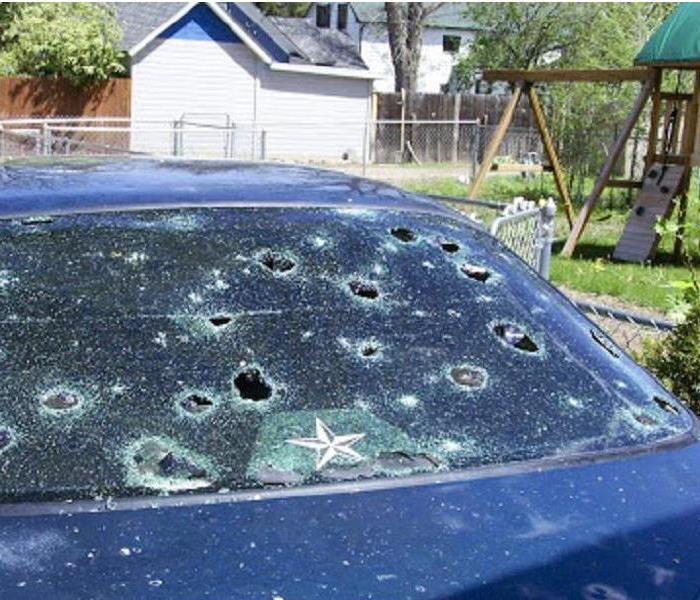 Car damaged by large hail
Car damaged by large hail
Severe Thunderstorm Straight-line Winds:
- Don’t underestimate the power of strong thunderstorm winds known as straight-line winds – they can reach speeds of 100 to 150 mph. Hurricane-force winds start at 74 mph. Illinois does experience these kinds of winds!
- If a severe thunderstorm warning contains hurricane-force wind speeds seek shelter immediately (as you would for a tornado situation).Stay away from windows and go to the basement or interior room/hallway. Do not use electrical appliances.
- Be aware that tall trees near a building can be uprooted by straight-line winds – that tree can come crashing through the roof of a home and crush a person to death.
- Powerful straight-line winds can overturn a vehicle or even make a person air-borne when they get up over 100 mph!
- One type of a straight-line wind event is a downburst, which is a small area of rapidly descending rain-cooled air and rain beneath a thunderstorm. A downburst can cause damage equivalent to a strong tornado!
Large Hail:
- Although it is rare, people have been killed by large hail stones after sustaining head injuries. Additionally, several people are injured by large hail stones each year in the U.S.
- Some thunderstorms can produce large hail stones that can reach the size of baseballs, softballs, or even as big as computer compact discs (CD) or DVDs! These large hail stones can fall at speeds over 100 mph! – that’s why they are dangerous!
- If a severe storm is producing large hail stones, seek a sturdy shelter and stay away from windows that can easily be smashed.
- If you are in your vehicle before the hail storm starts, get out of it and go to a sturdy shelter. Glass windows in vehicles can easily be smashed by the hail stones. If you can’t get out of your vehicle, then come to a stop and cover your head with your arms and hands.
Tornado Awareness
4/12/2017 (Permalink)
 Tornado watch vs tornado warning...know the difference.
Tornado watch vs tornado warning...know the difference.
All kidding aside, April is Tornado Awareness month. Are you prepared? Check out www.ready.illinois.gov for some great preparedness tips. If you have a business and no emergency plan in place, contact us at (630)862-3930 to set up your no cost Emergency Ready Profile.

 24/7 Emergency Service
24/7 Emergency Service
